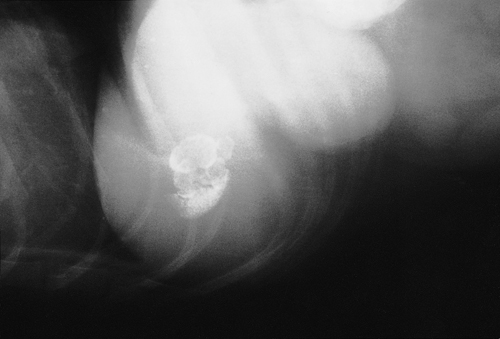Small Animal Soft Tissue Surgery Q&A 18
Jump to navigation
Jump to search
| This question was provided by Manson Publishing as part of the OVAL Project. See more Small Animal Soft Tissue Surgery Q&A. |
A right lateral radiograph of the cranial abdomen of a ten-year-old, female Schnauzer is shown.
| Question | Answer | Article | |
| What is the diagnosis? | Cholelithiasis |
Link to Article | |
| This disease is often insidious and asymptomatic in dogs. List the most common clinical signs in dogs that are symptomatic. | Vomiting, anorexia, weakness, polyuria/polydypsia, weight loss, icterus, fever and signs of abdominal pain are the most common clinical signs in dogs with symptomatic cholelithiasis. |
Link to Article | |
| The pathogenesis of this disease in dogs is unknown. Several causes have been proposed. Name the most likely ones. | Proposed causes include trauma, biliary stasis, diet alterations, cholecystitis, and parasitic and bacterial biliary infection. |
Link to Article | |
| Describe the surgical therapeutic options, and give the therapy of choice. | The treatment for cholelithiasis is cholelithotomy via cholecystotomy, cholecystectomy or choledochotomy. Cholecystectomy is indicated in dogs with cholelithiasis and concurrent cholecystitis and should be regarded as therapy of choice. |
Link to Article | |
